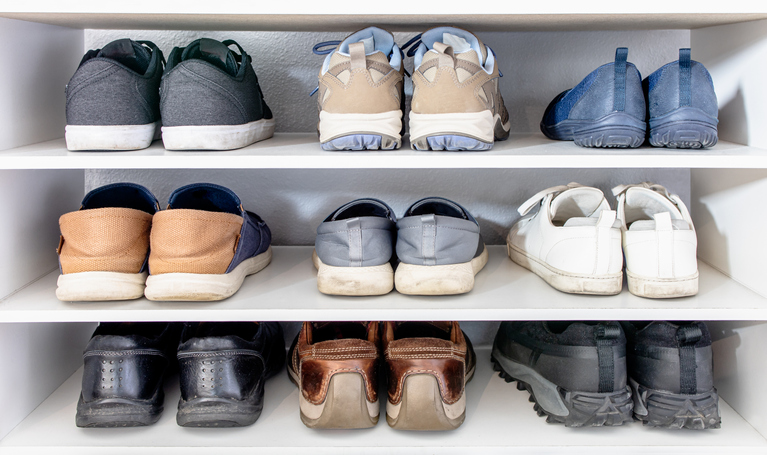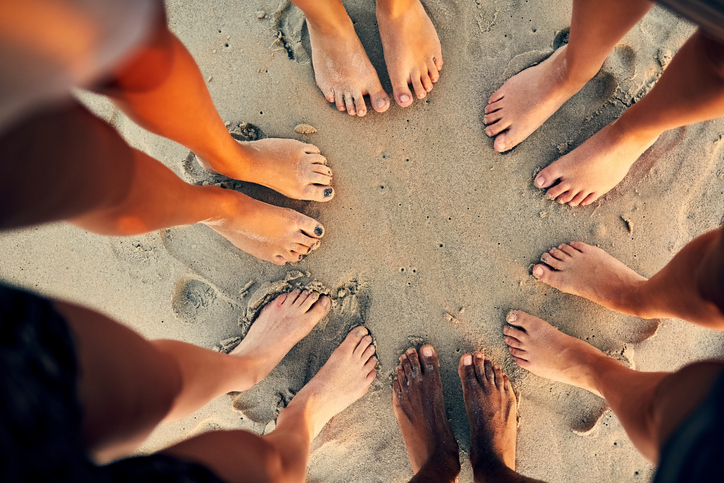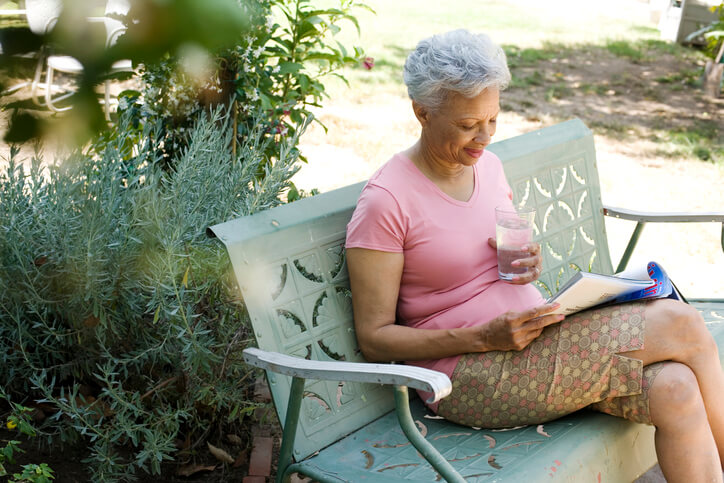By the time you reach age 50, your feet will have taken 75,000 miles worth of steps, according to the American Podiatric Medical Association (APMA). That’s a lot of mileage. If you want to continue putting your best foot forward, it’s important to make healthy feet part of your lifestyle. “Your feet help keep you active. That is really important as we age, because that is a great way to prevent systemic issues, like heart disease. Therefore, it’s important to get your feet checked out and make sure that they’re in full capacity to keep you going,” says Saylee Tulpule, DPM, podiatrist and spokesperson for APMA.
Healthy Feet: An Owner’s Manual
With proper detection, intervention and care, most foot problems can be lessened or prevented. Check out our tips to help you treat your feet with care.
Examine Your Feet Regularly
At least once a week, check your feet for any changing or unusual moles, lesions or open sores, especially if you have diabetes. Also, look for nail discoloration or fungus. Make sure you examine the bottoms of your feet and in between your toes. “Use a hand-held mirror or ask for help if you can’t see your soles,” Dr. Tulpule advises. See your healthcare provider if you find anything of concern.
Get an Annual Exam From a Podiatrist

When you reach 50, you’re more predisposed to falls, osteoarthritis and possibly systemic issues like diabetes and high blood pressure. That makes it doubly important to maintain healthy feet.
“People generally go to a foot specialist only when their feet hurt, but I think it’s really smart to get an annual foot and ankle exam. That way a professional can take a look at circulation and musculoskeletal conditions such as hammertoes, osteoarthritis and bunions, and check your sensation to make sure that you’re not pre-diabetic,” says Dr. Tulpule. The podiatrist can then recommend appropriate shoes and possibly orthotics. They can also offer stretching and range of motion exercises to help flexibility.
Maintain Good Hygiene
Wash your feet daily with non-irritating soap. Wipe them dry before putting on socks or shoes. Don’t forget to dry in between your toes. Wet, sweaty feet can cause odor, fungus and, in some cases, infections as constant moisture breaks down the skin, according to APMA. If your feet sweat a lot, invest in some moisture-wicking socks and change them often. Excessive sweating may mean you have hyperhidrosis; see a healthcare professional.
Exercise and Massage Your Feet
Flexing and stretching reduce cramping — point and curl your toes, rotate your ankles both ways. Self-massage with moisturizing lotion releases tension, boosts circulation and refreshes the skin, says APMA. Also, raise your legs if you have been sitting for a while. This reduces swelling in your feet and ankles.
Moisturize
Dry skin on feet can crack and split, allowing infection to set in. Use a mild cleanser and moisturize your feet daily, preferably right after your shower. The APMA has given its seal of approval to Amerigel Care Lotion, Flexitol Heel Balm and Kerasel Intensive Foot Repair.
Rotate Wearing Your Shoes

Changing up what shoes you wear gives them a chance to air out and dry, reducing the risk of odor, mold or fungus. It also lets your feet recover from any blisters or hot spots. Bonus: It also prolongs the life of your shoes.
Play It Safe at Nail Salons
Ask if the salon is using sterile instrumentation. If so, they should be opening a sealed bag that has been through an autoclave. Avoid salons that just put those nail instruments into liquid disinfectant (that blue solution). For pedicures, make sure that the salon filters and cleans the foot bath between clients. They should also cover the basin in plastic before you put your feet in to make sure that you’re not coming into contact with any germs or fungus left behind. Never allow them to use a razor to scrape dead skin or calluses because this can cause infections. The APMA also recommends you schedule your appointment early in the morning when the salon will be at its cleanest. Dr. Tulpule adds, “I tell my patients to take their own polish if they want to minimize risk of any sort of fungal infections.”
Prevent Ingrown Toenails
Usually found on your big toe, ingrown toenails occur when the side of the nail grows into the surrounding skin, causing pain, redness and sometimes infection, according to the Mayo Clinic. It can be caused by:
- Wearing shoes that are too tight
- Cutting your nails too short and curved
- Injuring the nail
Avoid ingrown nails by trimming toenails straight across and long enough to match the end of your toe. Also, wear shoes that fit properly.
Maintain a Healthy Weight
The American College of Foot and Ankle Surgeons reports that many studies have found an association between obesity and foot problems: “As little as one pound above your ideal weight can increase pressure in your hips, knees and ankles by as much as eight pounds. Simply walking up a flight of stairs or up an incline can increase pressure on the ankle by four to six times.”
Choose the Right Shoes
If your shoes are too tight, you can develop blisters, corns and sores. High heels increase your risk exponentially for falls and twisted or broken ankles. You can protect your feet best by wearing properly fitting and supporting shoes. The University of California San Diego Health offers these tips:
- Don’t buy shoes that don’t fit, thinking you can break them in or that they’ll stretch. It rarely works and only leads to blisters and pain.
- The toe box should leave a half-inch of space in front of your longest toe. The width should be enough that your toes don’t feel pinched or squished.
- Your back heel needs to fit snugly (but not too tight) in the shoe and shouldn’t pop out when you walk.
- Try on shoes with the socks you intend to wear or any orthotic inserts you need.
- Shop later in the day when your feet are generally larger.
- Don’t wear heels higher than 1.5 inches. If you like higher heels, save them for the occasional night out.
- Check for good foot support. Are the soles cushioned enough to protect your feet on impact? Do the shoe arches come up to your natural arch or are your natural arches flattening? Hold the shoe in one hand: If you can twist it, it will not provide enough support for healthy feet.
- Soles of shoes should have treads to prevent slipping. If not, a shoe repair person can easily add them.
- Wear sport-specific shoes for your athletic endeavors or risk developing plantar fasciitis, heel spurs and tendonitis.
- Brand name doesn’t necessarily mean better. Buy the shoes that fit, are comfortable and provide appropriate support.
Say Goodbye to Flip-flops
According to the University of Pittsburgh Medical Center, flip-flops provide no arch or ankle support, which can lead to foot pain or injuries, and a strained Achilles tendon. The toe thong can cause blisters that can get infected. If you must wear them, restrict it to where they are intended to be worn (at the beach) and look for cushioned flops that provide some arch support. If you’re going to wear them poolside, get ones with nonslip treads.
Walk This Way
Walking is an inexpensive, low-impact way to exercise with many known health benefits such as improving heart and bone health and reducing stress. Take care of your feet, and they will continue to take care of you.
How do you take care of your feet? What are your favorite supportive shoes?







I’m soon to be 85. I have Neuropathy in my feet, but it doesn’t bother me when I play tennis. I see a Podiatrist about every three months. I walk with my wife at a park for about 45 minutes about 5 times a weeks. I been on blood thinners about 15 years.
Thank you for sharing, Danny!
Your tips for healthy feet are excellent.
I do question one of your tips, though: “Check for good foot support. Are the soles cushioned enough to protect your feet on impact? Do the shoe arches come up to your natural arch or are your natural arches flattening? Hold the shoe in one hand: If you can twist it, it will not provide enough support for healthy feet.”
What I’m going to write now is not theoretical. I’m 86 years old, have bilateral intermittent claudication and hallux rigidus. From time to time over many years I have worn custom orthotics. As a younger man I participated in a variety of sports including running. During those earlier years I wore the best and latest athletic shoes money could buy. What I didn’t realize through those years was how wearing cushioned, form-fitting shoes were damaging my feet.
By the time I stopped running and switched to other sports, the damage to my feet had already occurred. I had custom orthotics made to relieve pain. They worked – as long as I wore them in specific shoes. When I tried wearing shoes that did not have the custom orthotics, my feet hurt in numerous places.
Finally, after much research I decided to try minimalist shoes – no heel elevation at all, thin soles, no arch support or padding, very flexible and a wide shoe box. It took a few weeks for me to get used to these “almost-barefoot” shoes, especially when walking outside on hard pavement or uneven terrain.
But it sure has been worth it! My wife and I only wear these shoes for everyday activities. I’ve given away all of my other shoes and have never looked back! So when you wrote about arch supports and the need for a more rigid shoe to prevent arches from flattening, I could not agree less.
Perhaps in some situations, such as peripheral neuropathy, padded, orthotic, arch supporting shoes are necessary. But with 26 bones and a whole array of muscles and tendons in each foot, each step sends signals to the rest of our body – for balance and more. If our feet are “protected” with comfortable shoes, yes pain will be diminished, but so will our ability to use our feet for stability, walking and more.
Thank you for sharing these insights, Matt!
I’m 62 on my feet 8 to 10 hrs a day excluding weekends and I just can’t find the right shoes I have high arche foot doctor said I have lost oall the fat that cushions The bottom of my feet I wear insoles but still in pain Does anyone have any good advice for me
When I felt my feet had an infection or nail fungus or even after a shower in a gym. I would soak my feet in distilled water and put in a little baking soda in my foot bath at home.
I have high arches, too, but I purchased custom-made for me orthotic arch supports from a podiatrist. They aren’t cheap but I can move them to any pair of shoes I am wearing. They have kept me pain-free for years, no matter how many hours a day I am on my feet!
A foot exercise I learned from the Reader’s Digest years ago is to stand behind a chair with my hands lightly on the back of it. I raise up on my toes and hold to the count of 3 (or longer if you can) at least 8 times. This keeps my arch muscles toned and has eliminated my plantar fascitis.
I am an RN and have worked on my feet for over 40 years. I have all kinds of foot problems, including high arches. I have found that SKETCHERS are the only shoes that I can wear comfortably. I recommend a lace-up shoe for work, slip-on shoes are comfy also, but I only wear them out and about. The lace-ups have more support.